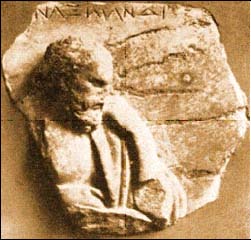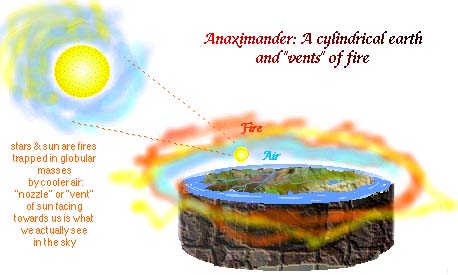Anaximander of Miletus

Life and Work
Anaximander (c.612-545 BC) was a discipline of Thales. He studied systematically the natural phenomena and he made the first comprehensive attempt to explain the origins both of man and the cosmos. Anaximander wrote a book in prose with the influential title On Nature. His thought includes significant theories on the fields of cosmology, cosmogony and biology. Anaximander was the first to draw the inhabited world on a map or tablet. He was also famous for explaining winds, rains, earthquakes and other natural phenomena in a rational non-mythological way.

Earth and Heavenly Bodies
For Anaximander the earth is cylindrical in shape; curved and round like a drum. Its surfaces are flat and stays in equilibrium at the center of the cosmos. The heavenly bodies are ‘breathing holes’ in the air. For Anaximander the first living organisms were born from moisture evaporated by the sun. Man was born from a different kind, a fish-like creature. That is because man, in contrast to other creatures, is not self-supporting but needs prolonged nursing.

The Apeiron
Anaximander is the first philosopher to say that the ‘principle’ (arche) and ‘element’ (stoicheion) of everything existent is the ‘unlimited’ (apeiron): it is the derivative source of all things. From the apeiron all things arise in coming-to-be and return by necessity in passing-away. The apeiron is the eternal originative substance without limits in (1) Space (2) Time (3) Quality (4) Quantity. It is this nature of the apeiron that brings it close to the ontological neutrality of the Hesiod’s Chaos.
Fragments and Testimonies
1(1) From the source from which they arise, to that they return of necessity when they are destroyed, 'for they suffer punishment and make reparation to one another for their injustice according to the assessment of time', as he says in somewhat poetical terms.
2 (A11 from Hippolytus) He said that the arche ('beginning and basis') of existing things is an apeiron ('limitless') nature of some kind, from which come the heavens and the kosmos ('world order') in them.
3(3) ... deathless and indestructible <the indefinite>
4(5) He compared the earth to a stone column section.
Translation M. R. Wright - note: numbers in parentheses refer to the standard Diels/Kranz order
Copyright 1997-2006
Giannis Stamatellos
E-mail: gstamap@yahoo.com
IONIANS
Thales of Miletus
Anaximander of Miletus
Anaximenes of Miletus
Heraclitus of Ephesus
Xenophanes of Colophon
PYTHAGOREANS
Pythagoras of Samos
Philolaus of Croton
Archytas of Tarantum
Alcmaeon of Croton
ELEATICS
Parmenides of Elea
Zeno of Elea
Melissus of Samos
PLURALISTS
Empedocles of Acragas
Anaxagoras of Klazomenes
Democritus of Abdera
BIBLIOGRAPHY
RELATED SOURCES